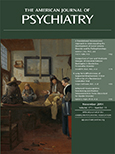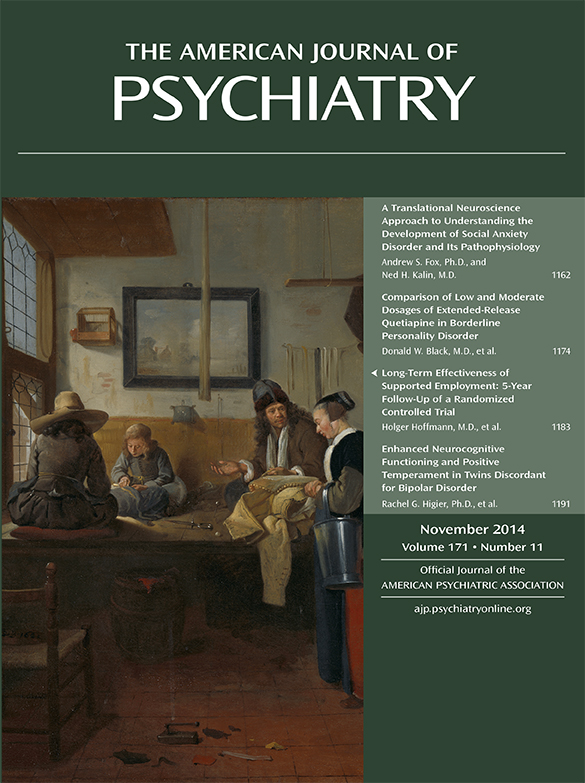Aristotle’s claim that “no great genius has ever existed without a strain of madness” (
1) has been cited by many professionals and patient advocacy groups over the years. However, the link between mental illness—bipolar disorder in particular—and exceptional cognitive or creative ability has been based mainly on anecdotal reports (
2). In this issue, Higier and colleagues (
3) try to shed light on why a disorder such as bipolar disorder, with a detrimental effect on brain function, maintains its prevalence across generations. Their hypothesis is that bipolar disorder is associated with traits that are advantageous to mate selection (e.g., creativity, sociability, positive affect) and thus counteract the disorder’s biological disadvantage. In other words, this is a model of reproductive fitness in which an allele with higher fitness will be more likely to be represented in future generations because of a feature of that allele—coding for the advantageous traits assessed in the study—and not because of random effects.
This hypothesis is based on previous studies, mainly population registries suggesting an association between enhanced cognitive functioning and risk for bipolar disorder (
4–
6). A 2010 study using the Swedish national registry (
7) in which 300,000 individuals with severe mental disorders were assessed, including more than 29,000 patients with bipolar disorder and 54,000 with schizophrenia, found an overrepresentation of creative professionals among individuals with bipolar disorder and healthy siblings of individuals with schizophrenia or bipolar disorder as compared with the general population.
Higier et al., using the Swedish Twin Registry, assessed bipolar and schizophrenia probands and their discordant co-twins, as well as a group of matched healthy controls, with a neuropsychological test battery and temperament questionnaires. Unaffected bipolar co-twins (twins of bipolar patients not affected with bipolar disorder) showed higher scores on a “positivity” temperament scale (e.g., traits of social ease, confidence, and assertiveness) compared with controls and bipolar probands, while bipolar probands scored higher on a “negativity” scale compared with their co-twins and controls, with no difference between the latter two groups. Along the same lines, unaffected bipolar co-twins scored higher than controls on tests assessing verbal learning and fluency. For all other neurocognitive assessments, unaffected bipolar co-twins were indistinguishable from controls, while bipolar probands exhibited performance decrements across all neurocognitive domains. As expected, unaffected schizophrenia co-twins scored in between controls and their proband counterparts in terms of positivity and overall neurocognitive functioning. Heritability estimates were calculated for positive temperament (0.44) and verbal ability (0.70).
The study has many strengths. The use of this unique Swedish cohort gives the authors very large group sizes from populations that are extremely difficult to gather otherwise. There were no significant differences in age, sex, handedness, or years of education among the five groups studied (healthy controls, schizophrenia probands, unaffected schizophrenia co-twins, bipolar probands, and unaffected bipolar co-twins).
One wonders if the bipolar probands might have had scores closer to those of their discordant co-twins had they been medication free. Over 30% of them were on antipsychotics, which, while reducing psychotic symptoms and risk of relapse, have been shown to produce negative symptoms (which may in turn produce lower scores on the positivity temperament scale used in the Higier et al. study) and impair cognition (
8). One of the key advantages of a population-based sampling approach, as employed here, is confidence that the studied probands are representative of the broader population of probands and that, by extension, the studied unaffected co-twins of bipolar probands are likely to be representative. Despite this, the results from this study may not be generalizable to all patients with bipolar disorders, such as bipolar patients with psychotic symptoms. This subgroup represented only 30% of the bipolar probands in the study, although all had bipolar I disorder, had experienced psychotic symptoms (which is at odds with clinical experience), had an early age at onset, and seemed to be more cognitively impaired, with low premorbid adjustment scores and lower academic scores (
9). It is not clear how the co-twins of such patients would have scored.
The authors interpret the endophenotype of better verbal skills, prosocial behavior, and positive affect present in bipolar probands as a partial explanation for the persistence of bipolar disorder in the population. Individuals who tend to be more verbal, outgoing and sociable, optimistic, and psychologically resilient may be viewed as more desirable partners. The interpretation of the results for schizophrenia, on the other hand, is burdened with the less appealing, less romantic version of persistence of the disorder through polygenic selection-mutation, where infertility is counterbalanced by many small-effect genetic variants in the population (e.g., de novo mutations), against which there is relatively low selection pressure. It would be interesting to test this hypothesis in this registry. Do co-twins of schizophrenia patients have fewer offspring than the general population and unaffected bipolar co-twins? The same registry used to test the hypothesis of this study could be used to test this confirmatory assumption.
The performance benefits observed in bipolar co-twins appear unique to specific personality and neurocognitive domains, rather than representative of a ubiquitous advantage. To me, this study also points to the need for lessons on how to get the best out of these individuals. There is some creativity in all of us, and from this study, it would seem that people more likely to develop bipolar disorder may even have some above-average forms of temperament and verbal abilities. We should try not only to incorporate this into the treatments we offer, but to see to it that our educational system does a better job of integrating children with different strengths and does not stifle their creativity.

